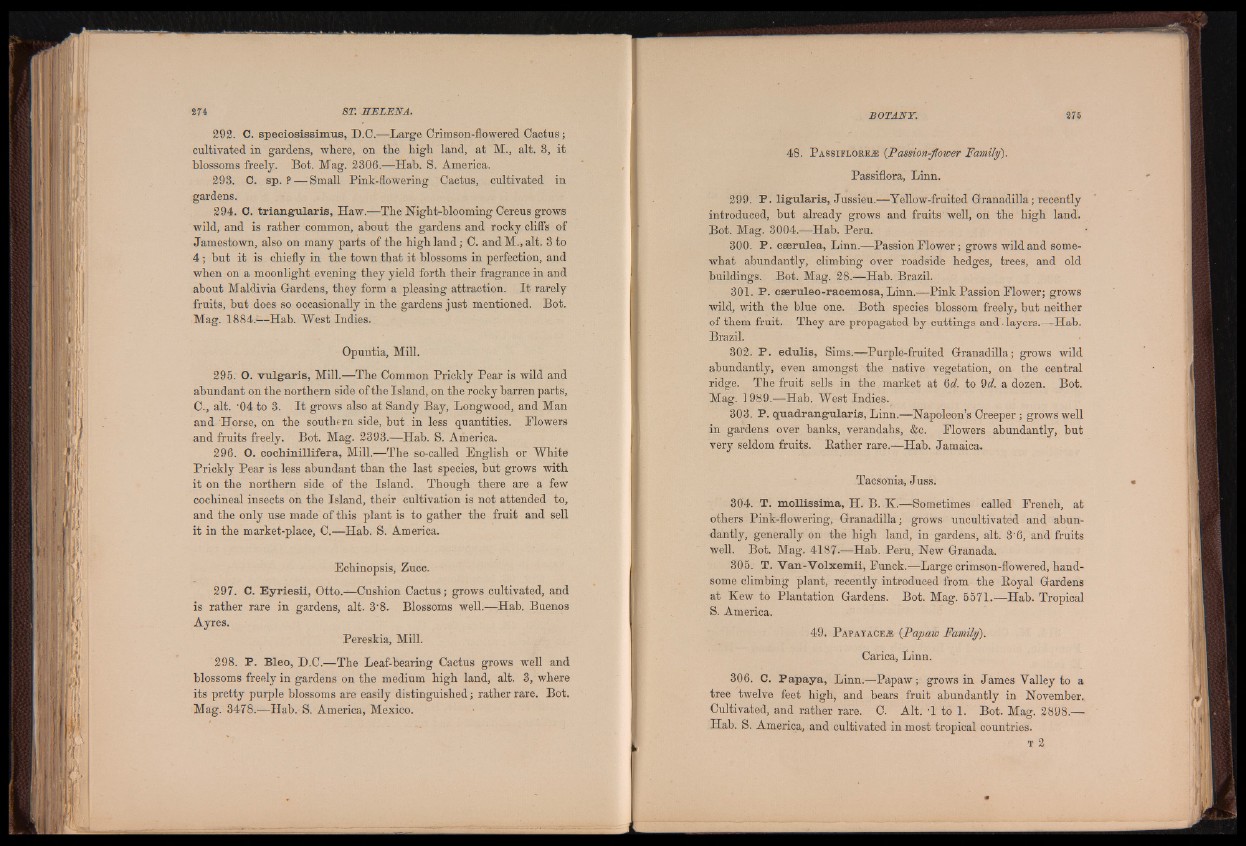
292. C. speciosissimus, D.C.—Large Crimson-flowered Cactus;
cultivated in gardens, where, on the high land, at M., alt. 3, it
blossoms freely. Bot. Mag. 2306.—Hab. S. America.
293. C. sp. ? — Small Pink-flowering Cactus, cultivated in
gardens.
294. C. triangularis, Haw.—The Night-blooming Cereus grows
wild, and is rather common, about the gardens and rocky cliffs of
Jamestown, also on many parts of the high land; C. and M., alt. 3 to
4 ; but it is chiefly in the town that it blossoms in perfection, and
when on a moonlight evening they yield forth their fragrance in and
about Maldivia Gardens, they form a pleasing attraction. I t rarely
fruits, hut does so occasionally in the gardens just mentioned. Bot.
Mag. 1884."—Hab. West Indies.
Opuntia, Mill.
295. G. vulgaris, Mill.—The Common Prickly Pear is wild and
abundant on the northern side of the Island, on the rocky barren parts,
C., alt. '04 to 3. I t grows also at Sandy Bay, Longwood, and Man
and Horse, on the southern side, but in less quantities. Plowers
and fruits freely. Bot. Mag. 2393.—Hab. S. America.
296. O. cochinillifera, Mill.—The so-called English or White
Prickly Pear is less abundant than the last species, but grows with
it on the northern side of the Island. Though there are a few
cochineal insects on the Island, their cultivation is not attended to,
and the only use made of this plant is to gather the fruit and sell
it in the market-place, C.—Hab. S. America.
Echinopsis, Zucc.
297. C. Eyriesii, Otto.—Cushion Cactus; grows cultivated, and
is rather rare in gardens, alt. 3'8. Blossoms well.—Hab. Buenos
Ayres.
Pereskia, Mill.
298. P. Bleo, D.C.—The Leaf-hearing Cactus grows well and
blossoms freely in gardens on the medium high land, alt. 3, where
its pretty purple blossoms are easily distinguished; rather rare. Bot.
Mag. 3478.—Hab. S. America, Mexico.
48. PassiflorejE (Passion-flower Family).
Passiflora, Linn.
299. P. ligularis, Jussieu.—Yellow-fruited Granadilla; recently
introduced, hut already grows and fruits well, on the high land.
Bot. Mag. 3004.—Hab. Peru.
300. P. cserulea, Linn.—Passion Flower; grows wild and somewhat
abundantly, climbing over roadside hedges, trees, and old
buildings. Bot. Mag. 28.—Hab. Brazil.
301. P. caemleo-racemosa, Linn.—Pink Passion Flower; grows
wild, with the blue one. Both species blossom freely, hut neither
of them fruit. They are propagated by cuttings and. layers.—Hah.
Brazil.
302. P. edulis, Sims.—Purple-fruited Granadilla; grows wild
abundantly, even amongst the native vegetation, on the central
ridge. The fruit sells in the market at 6at to 9d. a dozen. Bot.
Mag. 1989.—Hab. West Indies.
303. P. quadrangularis, Linn.—Napoleon’s Creeper ; grows well
in gardens over banks, verandahs, &c. Flowers abundantly, but
very seldom fruits. Bather rare.—Hab. Jamaica.
Tacsonia, Juss.
304. T. niollissima, H. B. K.—Sometimes called French, at
others Pink-flowering, Granadilla; grows uncultivated and abundantly,
generally on the high land, in gardens, alt. 3'6, and fruits
well. Bot. Mag. 4187-—Hah. Peru, New Granada.
305. T. Van-Volxemii, Funck.—Large crimson-flowered, handsome
climbing plant, recently introduced from the Boyal Gardens
at Kew to Plantation Gardens. Bot. Mag. 5571.—Hab. Tropical
S. America.
49. P a p a y a c e ® {Papaw Family).
Carica, Linn.
306. C. Papaya, Linn.—Papaw;. grows in James Valley to a
tree twelve feet high, and bears fruit abundantly in November.
Cultivated, and rather rare. C. Alt. T to 1. Bot. Mag. 2898.—
Hab. S. America, and cultivated in most tropical countries.
t 2